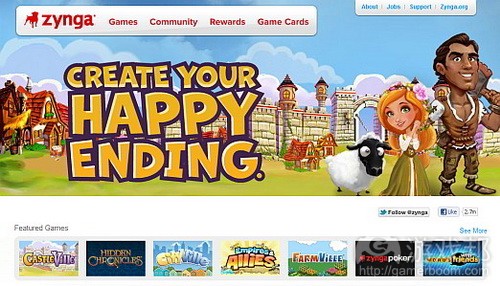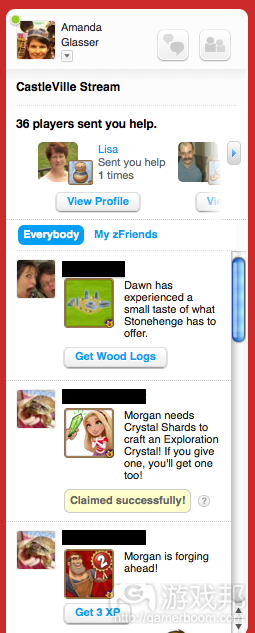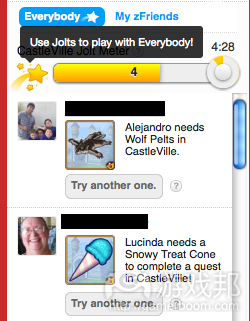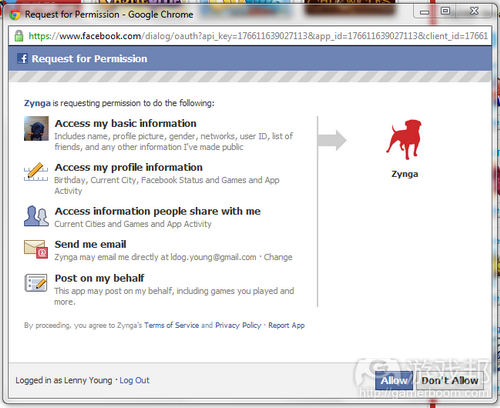分析Zynga.com上线两个月表现情况
作者:AJ Glasser
Zynga的非Facebook游戏平台依然处在初级阶段,但保持发展势头,平台的游戏作品依然处于运作之中。以下是Zynga.com自3月份公开测试以来的表现情况。
流量
和多数社交游戏一样,平台头6-8周的流量保持上升趋势。平台公开发布一周后就呈现发展势头,最初的内部测试结果是MAU约170万,DAU约13万。经过七天,MAU提高11%,增至190万,DAU提高38%,达到18万。截止当月末,Zynga.com的MAU和DAU分别是220万和23万。到四月底,数据进一步提升,MAU和DAU分别达到280万和42万。
有趣之处在于:Zynga的DAU/MAU(游戏邦注:这是用户留存率的衡量标准)在头两个月也维持发展趋势。
通常,社交游戏刚发行时,MAU和DAU会呈发展态势,而留存率则呈相反态势。其首席运营官John Schappert表示,Zynga有意回避使用广告或交叉推广渠道将用户吸引至Zynga.com的方法。这令平台的发展势头显得更富有意义,因为这属于自然发展,主要通过品牌辨识度或发送给Facebook好友的邀请实现流量增长。
Zynga表示,Zynga.com的广告宣传活动将于本季度末启动。
游戏功能——工具条(Sidebar)
工具条版块随时出现在Zynga.com页面的右侧边,除非游戏切换至全屏模式。在版块顶部,玩家可以通过点击自己的名称访问游戏介绍、最近玩过的游戏列表(列表将呈现有待回复的游戏请求数量)、RewardVille剩余积分或设置菜单。玩家可以选择退出系统或启闭聊天功能。此外,模块顶部还有两个按键,主要是用于生成聊天视窗或好友列表(这被称作zFriends)。
剩余的模块变化主要取决于用户在Zynga.com的具体位置。在游戏主页或介绍页面,用户会看到zFriends列表,用户根据当前在线及最近玩过Zynga游戏分类进行排序。这部分模块可以用于呈现推荐zFriends列表——有些和用户在Facebook并非好友。游戏中,玩家会看到最近给过他们帮助的横向用户列表或是其他同款游戏玩家的活动即时动态。即时动态会根据当前在线或玩过此款游戏的zFriends用户进行排序。
我们还会在工具条中看到Zynga通过Google AdSense提供的广告服务,但这种情况只存在于用户在没有融入即时动态功能的游戏中浏览工具条。
游戏功能——即时动态(Live Feed)
玩家在玩《CastleVille》、《CityVille》和《Hidden Chronicles》时,Zynga的即时动态会出现在工具条中。其发布zFriends和陌生人发出的游戏请求,让玩家能够通过点击消息内容,送出及接收奖励。即时动态对平台来说非常重要,因为相比Facebook,通过Zynga.com玩游戏的主要优点在于,若他们的游戏请求得到同步回应,而非基于异步形式,玩家就能够获得更快进展。这让玩家能够接触到可能在游戏中给予自己帮助的用户,这样用户就不需要向自己的Facebook好友发布垃圾信息,期待其中有人和自己玩同款游戏。
这是Zynga.com平台过去两个月变化最大之处。最初,平台用户数量不多时,即时动态更像是Facebook平台的即时Ticker更新内容。用户可以点击消息内容,接收同消息绑定的奖励,同时在公告栏发布自己索要的道具。在Zynga游戏中,由消息生成的请求只有特定数量的附属奖励——只要奖励被送出,玩家就无法再通过点击消息内容接收或发送道具。
事实证明这供大于求——玩家通常会在点击即时动态消息时收到这样的消息:所有奖励都已送出。Zynga.com总经理Manuel Bronstein及首席产品经理Reed Shaffner表示,即时动态消息的用户平均点击次数是200次/回合。
Bronstein表示,这一策略不是要改变供给方,而是要通过若干不同渠道调节需求量。最明显的就是完善不同用户群体的划分,这样动态消息就会引入合理的用户数量。其次,开发者调节不同动态消息的刷新率,降低消息在即时动态栏的显示速度,这样玩家就不会争相点击顶部出现的所有内容。最后,平台团队引入所谓的Jolts机制(游戏邦注:这一机制只维持一周时间,因为用户对此不感兴趣)。
下面是Jolts在这一短暂期间的运作模式:玩家在既定时间内接收固定数量的Jolts,以此换取即时动态栏中的消息点击。和能量测量计一样,它限制玩家在一个回合内和即时动态消息的互动次数。它还促使玩家得以“管理”即时动态栏的消息内容,只锁定他们希望获得的奖励。当玩家耗尽Jolts时,就只能等待Jolt测量计再次获得填充,或通过体验其他Zynga.com游戏赚得额外Jolts。
Bronstein和Shaffner探索的最后一个选项是,如何更好告知用户,所有奖励都已送出。除此之外,他们还积极突出玩家赚得的奖励。就算玩家点击200次,并且只有一半获得奖励的机会,他们还是能从中得到100次的免费道具。
还有一个问题是,如何在看似没有用处的地方应用即时动态。目前《Zynga Poker》和《Words With Friends》将即时动态用于推荐新zFriends及广告服务。
游戏功能——快速加载(Fast Load)
当用户选择退出游戏时,网站就会出现快速加载按键。点击这一按键会将玩家带回至之前停止操作的位置,且不会呈现加载页面。这是个非常便捷的功能,未来有望发挥更大作用,因为Zynga逐步在网站中添加更多功能,这可能会促使玩家放弃游戏,转投另一内容或社区活动。这是Zynga.com独创的功能,若用户对于快速加载canvas应用的需求越来越大,未来Facebook有可能也会植入这一功能。
用户资料
Zynga.com用户资料主要着眼于用户同游戏的互动方式、显示倍受青睐的游戏作品、最近游戏活动、平台zFriends、用户帮助过的好友数量及本周用户给予好友的帮助次数。过去两个月,用户资料并没有得到什么更新,虽然如今资料页面和主页的工具条会告知用户,最近哪些好友玩过Zynga游戏。
有趣的是,这一模块的资料图像会显示好友是否在Zynga.com或Facebook玩游戏,因为Zynga.com的所有游戏都和Facebook页面同步。Facebook好友的资料图像底部会有个Facebook图标,而Zynga.com好友则没有图标。两个平台的玩家都会在其资料图片的上方收到一个图标,显示他们最近最常玩的平台游戏。这是唯一可区分Zynga.com用户和Facebook用户的地方。
最后,资料页面是Zynga提供广告服务的另一场所。目前,我们只在自己的资料页面上遇到过家具专卖店One King’s Lane(游戏邦注:Zynga首席执行官Mark Pincus的妻子Alison Pincus是One King’s Lane联合创始人)的横幅广告。这些广告主要显示在页面下方,位于最近游戏活动的旁边,通常需要玩家滚动屏幕,方能看到整个广告内容。
发展空间
虽然Zynga不愿公开玩家游戏频率及具体留存率数据,但Zynga.com游戏的粘性有望高过目前的Facebook。Bronstein和Shaffner分享了一个新出现的用户行为:玩家会登陆Zynga.com玩游戏,接着在Facebook再次进行体验,在上次中断的地方继续游戏。Bronstein将此归功于平台团队早期做出的决策,令平台的游戏体验同Facebook页面(游戏邦注:其将Credits作为唯一的付费方式)保持连贯性及同步。Bronstein称平台的创收“很不错”,但拒绝透露具体细节。
再来就是平台的同步性质。页面左侧的Zynga商标下方有个计时器,主要计算当前活跃于平台的用户数量——60秒刷新一次。在我们进行游戏体验时,这一数据已增至180万人;Zynga拒绝提供具体数据。即时动态道具的高度需求也足以说明问题,虽然我们很难统计其中的具体数据。
潜在问题
目前,平台不存在刻意阻碍用户在Zynga.com体验游戏的功能。但问世短暂的Jolts机制充分说明,限制玩家活动的功能并不适合Zynga.com。同步性也是Zynga在管理平台方面遇到的一大挑战,因为该公司最先接触的是Facebook异步模式,也许尚未做好管理众多机制需求的准备。
将Facebook用户转变成Zynga.com用户存在若干问题,因为用户需要批准新的访问授权,方能使用Zynga.com平台。平台的对话呈现方式也会让不了解情况的玩家保持谨慎态度,因为比起具体的游戏,他们会不解为何要让一家公司访问他们的数据,
真正阻碍Zynga.com发展的因素是曝光度。Facebook及其他游戏网络都在积极探索帮助玩家发现游戏的最佳方式,目前尚没有所谓的完美解决方案。Bronstein表示,平台团队会考虑诸如好友推荐游戏(或其他社交曝光方式)、评价机制(或其他排序方式)之类的模式。目前,Zynga.com只有五款游戏,开发者完全有充足时间探索新解决方案。(本文为游戏邦/gamerboom.com编译,拒绝任何不保留版权的转载,如需转载请联系:游戏邦)
Zynga.com — two months old and 2.8 million MAU
By AJ Glasser
Zynga’s off-Facebook games platform is still in its early days, but the growth is there and the games are running. Here’s how Zynga.com has evolved since entering open beta in March.
Traffic
Like most social games, the only place for traffic to go in the first six to eight weeks is up. Growth kicked in one week after the beta launch, starting from around 1.7 million MAU and 130,000 DAU likely left over from an internal beta test. In seven days, MAU grew 11 percent to 1.9 million while DAU went up 38 percent to 180,000. By the end of the month, Zynga.com was at 2.2 million MAU and 230,000. Now, at the beginning of April, it’s up to 2.8 million MAU and 420,000 DAU.
Here’s what’s interesting: Zynga’s DAU as a percentage of MAU (which is a measure of retention) also consistently rose during the first two months.
Normally, when a social game launches, we see MAU and DAU rise while the retention rate falls. During Zynga’s Q1 2012 earnings call, COO John Schappert explained that Zynga deliberately hasn’t driven users to Zynga.com via advertising or cross-promotion. This makes the platform’s growth seem even more significant, as it’s all organic, presumably from brand recognition or invites sent to Facebook friends.
Zynga tells us that advertising for Zynga.com will be turned on later in the quarter.
Game Features – Sidebar
The sidebar module appears on the right side of the screen everywhere on Zynga.com except when a game is in fullscreen mode. At the top of the module, players can click on their name to access their profile, list of recently played games (each of which display the number of pending game requests), their RewardVille point balance or the settings menu. They can also logout or toggle chat availability on or off. Also at the top of the module are two buttons that produce a chat window or a list of friends (called zFriends).
The rest of the module changes depending on where the user is on Zynga.com. On the homepage or profile page, users see a list of zFriends sorted into those currently online and those that have played Zynga games recently. This part of the module can be toggled to show a list of suggested zFriends — some of which are not on friends with the user on Facebook. In games, the user might see a horizontal list of users that have recently helped them in-game (with links to those users’ profiles) or a live feed of activity from other players of that game. The live feed can be sorted by everyone playing that game at the time or only zFriends that have played the game.
The sidebar is also a place where we’ve seen Zynga serve ads via Google AdSense, but this has only occurred when viewing the sidebar in a game that doesn’t make use of the live feed.
Games Features – Live Feed
Zynga’s live feed (sometimes called “social stream” or “zFeed”) is a feature that currently appears in the sidebar when playing CastleVille, CityVille and Hidden Chronicles. It posts in-game requests made by both zFriends and strangers, allowing players to click on any story to send and receive rewards. The live feed is important to the platform because the main value of playing a game on Zynga.com versus Facebook is that players progress faster if their game requests are answered synchronously instead of asynchronously. It’s also a means of meeting new friends that are more likely to help you in games so that users don’t have to spam their Facebook friends list, hoping some of them play the same games.
This is where Zynga.com has seen the most change in the last two months. At first, when there were fewer users on the platform, the live feed functioned much like the real time Ticker updates on Facebook. Users would click on a game story and receive the rewards attached to that story while also sending the poster the item they’d requested. As has always been the case with Zynga games, each story generated from a request only has a certain number of rewards attached to it — and once they’ve all been distributed, a player can no longer click on that story to receive or send items.
As it turns out, supply exceeded demand — more often than not, people were clicking on live feed stories and receiving a message that all the rewards had already been claimed. Manuel Bronstein and Reed Shaffner, Zynga.com’s general manager and lead product manager, tell us that the average user clicks on stories in the live feed 200 times per session (they declined to give session lengths — but assuming Zynga.com sessions are comparable to Facebook’s five to 20 minute range, that’s a lot).
The trick, Bronstein says, was not to change the supply side (which could unbalance the game), but to adjust demand using several different methods. The most obvious one was improving sharding of different user segments so that an optimal number of players populated a feed. Next, the developer tweaked refresh rates for different feeds, slowing down the rate at which stories appeared in the feed so that people weren’t just racing to click whatever was at the top. Lastly, the platform team introduced something called the Jolts system, which lasted barely a week as it was unpopular with users.
Here’s how Jolts worked for the brief time we had them: Players received a fixed number of Jolts in a given time period to spend on clicking live feed stories. Like an energy meter, it limited the number of times a player could interact with the live feed during a session. It also allowed players to “curate” stories from the feed, looking only for the rewards they actually wanted to have (e.g. currency instead of energy refills). When players ran out of Jolts, they could to wait for the Jolt meter to refill or could earn bonus Jolts by playing other Zynga.com games.
The last option that Bronstein and Shaffner are exploring is how best to communicate to the user that all the rewards have been claimed. Beyond that, they’re looking for a way to highlight the rewards that players do earn. Even if someone clicked 200 times and only got rewards half of the time — that’s still 100 free items. Platform terminology is something we expect to continuously evolve as Zynga looks for ways to explain platform features and systems to users.
There is also the question of how best to use live feed in games where it doesn’t apparently have a use. Currently, Zynga Poker and Words With Friends use the live feed space as an area to recommend new zFriends and possibly serve ads (see below). Bronstein and Shaffner say there is likely more that can be done for these games and others where request fulfillment doesn’t drive gameplay.
Game Features – Fast Load
The fast load feature is a button that appears on the site whenever a user exits a game. Clicking this button takes the user back into the game exactly where they left off without ever showing the user a loading screen. This is a very convenient feature that will likely gain more value as Zynga adds more features to the site that could potentially draw someone out of one game and into another or into a community event (e.g. a tournament or some other group activity). This is one Zynga.com-created feature that we could see Facebook adopting in the future if enough demand for quick-loading canvas apps emerges.
User Profiles
The Zynga.com user profile focuses on the way a person engages with games, displaying most-played games, recent games activity, zFriends on the platform and the number of friends the user has helped and the number of times they’ve helped friends in games for the week. In the past two months, the profile itself hasn’t gotten much of an update, although the sidebar on the profile page and the homepage now shows users which of their friends have played Zynga games recently.
Interestingly, the profile pictures displayed in this module indicate whether a friend is playing games on Zynga.com or on Facebook as all games on Zynga.com are synchronous with Facebook canvas. Facebook friends have a Facebook icon on the bottom of their profile picture while Zynga.com friends do not. Both players will receive an icon in the upper part of their profile picture indicating which platform game they’ve played most recently (no game icon seems to mean that user hasn’t played a Zynga game). Nowhere else on the site does Zynga.com differentiate between platform and Facebook players.
Lastly, the profile page is another venue where Zynga has explored serving display ads. So far, we’ve only encountered banner ads for furniture boutique One King’s Lane (which incidentally was co-founded by Alison Pincus, Zynga CEO Mark Pincus’s wife) on our profile page. These appear farther down the page beside the recent games activity feed, often requiring a user to scroll in order to see the entire ad.
The Potential
While Zynga declined to share session times or specific retention numbers, it seems as though engagement for Zynga.com games has the potential to be higher than what those games currently see on Facebook. Bronstein and Shaffner did share an emerging user behavior where players would log into Zynga.com to play a game — and then play the game again on Facebook later, picking up where they’d left off. Bronstein says Zynga owes this new behavior to the early decision the platform team made on keeping the game experience consistent and synchronous with Facebook canvas, right down to Credits as the sole payment method. Bronstein reports that monetization on the platform is “good,” but declined to elaborate.
The other thing that seems to be working is the synchronous nature of the platform. The counter that appears below Zynga’s logo on the lefthand side of the screen counts the number of users active on the platform concurrently — and refreshes every 60 seconds. That number has gone as high as 1.8 million during our own sessions; Zynga declined to give a specific number. The high demand for items out of the live feed also serves as proof of concept, even if there are some complications in managing demand.
Possible Pitfalls
At present, there are no features on the platform that prevent a user from playing games on Zynga.com as intended. The short-lived Jolts system, however, reveals that any sort of limitation on player activity will likely not work for Zynga.com. Synchronicity will also be an ongoing challenge for Zynga to manage on its platform, as it comes from an asynchronous background on Facebook and may not be prepared to manage demand across a broad range of systems.
There may be some issues in getting Facebook users to convert to Zynga.com players, on account of users having to approve a new set of permissions in order to use Zynga.com. The way the dialogue appears (see below) may also make less-informed users wary, as they may be confused by giving a company access to their data, versus a specific game.
What could really hinder Zynga.com’s growth down the line is discoverability. Facebook itself and many other games networks have struggled with the best way to help users find games, and no one solution has proved perfect. Bronstein says the platform team will consider everything from friend-recommended games and other types of social discovery to ratings systems or other means of sorting. Currently, with just five games on Zynga.com, it’s not a problem the developer has had much time to experiment with solving.(Source:insidesocialgames)
















































 闽公网安备35020302001549号
闽公网安备35020302001549号